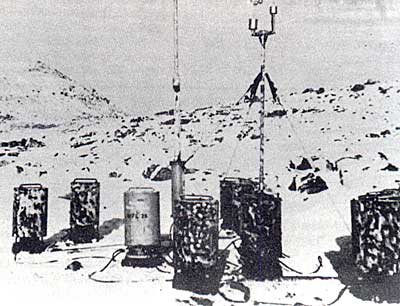Nazi Kurt captured in Arctic Circle in 1981 June 27, 2010
Author: Beach Combing | in : Contemporary , trackback
Beachcombing has long been fascinated by the last Japanese soldiers to surrender in the Second World War, several of whom crawled around the jungle islands of the Pacific for decades. Indeed, the very last, Nakamura, only came in from the cold in December 1974 after living for an incredible thirty years in the wilderness on the Indonesian island of Morotai. But these stories are relatively well known. Beachcombing thought that he would set out today a less famous story: the adventures of a renegade German ‘combatant’, Kurt, who was only discovered in 1981 on the coast of Labrador (today Canada then Newfoundland).
First some background. From the beginning of the war the Germans had sent their weather boats and weather specialists to the Arctic north in an attempt to find out what weather fronts were sweeping into Europe. This proved a dangerous job, not least because the Allies had broken the relevant codes. Abwehr weather crews, in fact, suffered disaster after disaster. One of Beachcombing’s favourite stories is of the small group of German meteorologists who fought off the Sledge Patrol, essentially Greenland’s army (made up for the most part of Danish and Norwegian nationals), after the Germans had set up base on that country’s northern coast to take wind readings. Have weathermen ever, before or since, been so combatative? Certainly, ‘the Weather Wars’ deserve a biographer and a four-hundred-page book.
As the war progressed the Germans established that unmanned weather stations could get most of the information back to Berlin without risking valuable personnel in the frozen fiords and bays of Norway and Greenland. They could also be taken even further from home. Enter Kurt, not a conventional Soldat, but rather a tripod, a radio mast and several dry cell batteries.
22 October 1943 the German submarine U-537 arrived at the tip of Martin’s Bay on the coast of Labrador, at that date Newfoundland rather than Canadian territory. It took the crew 48 – naturally tense – hours to row all the necessary equipment ashore and bring Kurt to the top of a local hill where he was set up. It was one of the uboat’s first missions: almost a year later, 9 November 1944 U-537 was sunk off Bali by an American submarine, going down with all hands.
Kurt – made naturally by Siemens! – was luckier. He immediately went ‘into combat’ broadcasting eight times a day for a couple of minutes on each occasion, giving valuable information about wind speed and wind direction. Beachcombing doubts that any German spy anywhere in the world was this efficient.
And, incredibly, no one spotted/heard/saw him.
1944 came and went – Kurt whispered static across thousand of miles to the homeland. In 1945 Hitler shot himself in the temple – Kurt remained undetected. The Red Army enslaved the east of Europe – Kurt shivered in the Labrador cold. Suez, the Beatles, Flower Power, Margaret Trudeau walking out with Mick Jagger, even Ronald Reagan as president… Kurt, last servant to the Reich, persevered.
The only reason, in fact, that Kurt was found out in 1981 was an effort from the homeland. The single survivor of U-537, Dr Sommermeyer – who had not gone with the submarine into the Pacific, had left, after his death, some papers and photographs and a retired Siemens engineer learnt of Kurt’s existence. He contacted the Canadian authorities – what would Admiral Canaris have said? – and a party was sent out to bring Kurt in.
The story ends happily enough. Kurt stands today in full battle order in the Canadian War Museum in Ottawa: one of its most prized possessions. And with some reason Dr Graeme Mount called Kurt ‘perhaps Nazi Germany’s greatest espionage achievement… in what is today Canada’ (Canada’s Enemies, p. 66).
A question that Beachcombing has often asked himself is how is it that no Inuit ever came upon Kurt? Or was it just that they did but that they were not suspicious? Allegedly American cigarette packs were left around when the U-boat crew set Kurt up and the Germans cunningly marked Kurt as belonging to the ‘Canadian Meteorological Service’. Still almost forty years… And another more technical point. Just how long would those batteries have lasted? [DrbeachcombingATyahooDOTcom]
***
Canadian blogger Christopher Moore kindly informed Beachcombing that a book on the Weather Wars already exists – woops! Wilhelm Dege, War North of 80. Looking at the contents on the net it is not perhaps the total history that Beachcombing was fantasising about. But it promises a lot and a copy is already winging its way Beachcombingwards. CM also states – though he didn’t have the relevant paperwork to hand – that Kurt had been spotted many times between 1943 and 1981, but that it was only the contact from Germany that allowed Kurt to be recognised for what he was – a Nazi weather station deep in Allied territory. Beachcombing is still hoping for an answer to his technical question from Siemens: how long did those batteries keep broadcasting to Berlin? Thanks to Christopher!



